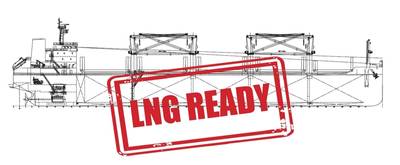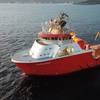DNV GL Gas Ready Notation
With the IGF Code practically finalized, the introduction of sulphur limits and burgeoning infrastructure and production capability, LNG as a ship fuel is spreading rapidly through the maritime world.
DNV GL’s new GAS READY notation gives owners, who at the new building stage want to prepare their vessel for a potential conversion to LNG operation after delivery, a useful framework for contracting. It provides a clear picture of the level of LNG fuelled preparedness of their vessel, as well as guidance on the scope of the contemplated work to all involved parties.
“We developed the new GAS READY notation based on the experience we have gained from our LNG Ready service as well as the 50 LNG fuelled vessels we already have in class with our GAS FUELLED notation”, says Torill Grimstad Osberg, DNV GL Head of Section for LNG Cargo Handling & Piping systems. “This new notation enables owners to ensure that a future LNG fuelled version of the vessel complies with the relevant safety and operational requirements, while also being very useful in helping owners specify and quantify the level of investment they are making at the newbuilding stage.”
The basic notation with nominators D and MEc – GAS READY (D, MEc) – verifies that the vessel is in compliance with the gas fuelled rules in terms of its overall design for future LNG fuel operations and that the main engine can be converted or operate on gas fuel. The owner can also choose to add extra optional levels to the newbuilding under the notation. These cover selections such as structural reinforcements and the choice of correct materials to support future LNG tanks (S), preparations for future gas fuel systems (P), certification and installation of LNG fuel tanks (T), and the installation of machinery, which can be converted gas fuel, or which is already capable of burning gas fuel - putting the vessel further along the LNG track and thereby speeding and simplifying a later conversion.
In 2014 the industry hit a significant milestone with over 120 LNG fuelled ships in operation or on order worldwide (excluding LNG carriers). The vast majority of these ships already operate or will be built to DNV GL class, a result of the trust the industry places in DNV GL due to our long involvement in this technology and our continually evolving technical expertise.
“DNV GL’s unique LNG Ready service has been in place for over two years and has proven its value in assisting many shipowners, operators, yards and designers in identifying the most attractive compliance option for their ships.
Through a detailed technical and financial feasibility study, the LNG Ready service investigates all the potential options for compliance and fuel cost reduction, uncovers any technical showstoppers, as well as calculating the financial attractiveness of each option”, says Dr Gerd-Michael Wuersig, DNV GL’s Segment Director for LNG fuelled ships. “The new class notation GAS READY provides a formalised framework for documenting the compliance option and preparation level chosen, and thereby is a natural extension of the LNG Ready service.”
Over the past decades DNV GL has undertaken extensive research and has implemented many projects world-wide with industry partners covering the regulatory framework, infrastructure and bunkering for LNG fuelled vessels. At DNV GL we have been helping companies and authorities to utilize LNG safely as a source of clean, reliable energy in the maritime industry through a complete set of services for nearly 20 years. With our breadth of services and global outreach delivered through our regional gas and LNG ready teams we have the capability to serve our customers wherever they might be.













